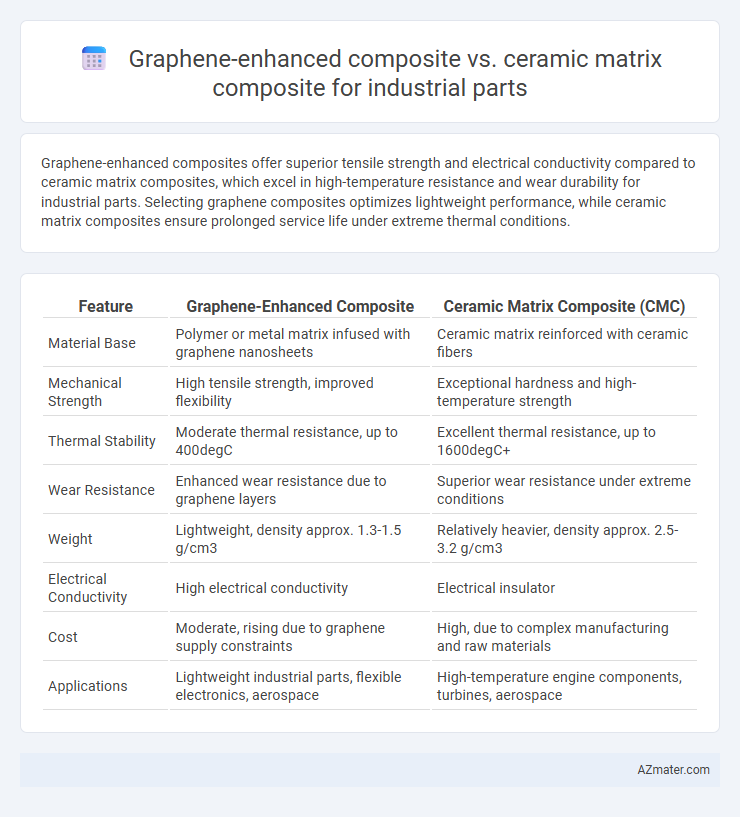Graphene-enhanced composites offer superior tensile strength and electrical conductivity compared to ceramic matrix composites, which excel in high-temperature resistance and wear durability for industrial parts. Selecting graphene composites optimizes lightweight performance, while ceramic matrix composites ensure prolonged service life under extreme thermal conditions.
Table of Comparison
| Feature | Graphene-Enhanced Composite | Ceramic Matrix Composite (CMC) |
|---|---|---|
| Material Base | Polymer or metal matrix infused with graphene nanosheets | Ceramic matrix reinforced with ceramic fibers |
| Mechanical Strength | High tensile strength, improved flexibility | Exceptional hardness and high-temperature strength |
| Thermal Stability | Moderate thermal resistance, up to 400degC | Excellent thermal resistance, up to 1600degC+ |
| Wear Resistance | Enhanced wear resistance due to graphene layers | Superior wear resistance under extreme conditions |
| Weight | Lightweight, density approx. 1.3-1.5 g/cm3 | Relatively heavier, density approx. 2.5-3.2 g/cm3 |
| Electrical Conductivity | High electrical conductivity | Electrical insulator |
| Cost | Moderate, rising due to graphene supply constraints | High, due to complex manufacturing and raw materials |
| Applications | Lightweight industrial parts, flexible electronics, aerospace | High-temperature engine components, turbines, aerospace |
Introduction to Advanced Composites in Industry
Graphene-enhanced composites offer exceptional electrical conductivity and superior mechanical strength compared to traditional materials, making them ideal for lightweight industrial parts requiring high performance. Ceramic matrix composites provide outstanding thermal stability and wear resistance, essential for components exposed to extreme environments such as turbines and aerospace engines. Both advanced composites significantly improve durability and efficiency in industrial applications, with graphene variants excelling in flexibility and conductivity, while ceramic composites dominate high-temperature resilience.
Overview of Graphene-Enhanced Composites
Graphene-enhanced composites integrate graphene nanosheets into traditional composite matrices, significantly improving mechanical strength, thermal conductivity, and electrical properties compared to ceramic matrix composites (CMCs). These composites exhibit superior resistance to wear and corrosion, making them highly suitable for demanding industrial applications requiring lightweight yet durable materials. Their enhanced fatigue resistance and higher toughness also contribute to longer service life and reduced maintenance in industrial parts.
Defining Ceramic Matrix Composites (CMC)
Ceramic Matrix Composites (CMC) consist of ceramic fibers embedded within a ceramic matrix, delivering exceptional high-temperature resistance and mechanical strength for industrial parts in aerospace, automotive, and energy sectors. Compared to graphene-enhanced composites, CMCs provide superior thermal stability and fracture toughness, essential for components subjected to extreme thermal and mechanical stresses. The enhanced durability and oxidation resistance of CMCs enable prolonged service life in harsh industrial environments where conventional materials fail.
Mechanical Properties Comparison: Strength and Toughness
Graphene-enhanced composites exhibit superior tensile strength and exceptional fracture toughness compared to ceramic matrix composites, making them ideal for industrial parts subject to dynamic loading. The incorporation of graphene provides enhanced crack deflection, energy absorption, and improved interfacial bonding, whereas ceramic matrix composites offer high-temperature stability but generally lower toughness and impact resistance. Mechanical testing reveals graphene composites achieve higher tensile strength values exceeding 1 GPa and toughness improvements of up to 50%, outperforming ceramic counterparts under mechanical stress conditions.
Thermal Performance: Conductivity and Resistance
Graphene-enhanced composites exhibit superior thermal conductivity, reaching values up to 5000 W/mK, significantly outperforming ceramic matrix composites (CMCs), which typically range between 20 to 60 W/mK. This high conductivity in graphene composites enables more efficient heat dissipation in industrial parts subjected to extreme thermal loads. Conversely, CMCs provide exceptional thermal resistance and stability at temperatures exceeding 1600degC, making them ideal for high-temperature applications requiring durability and minimal thermal expansion.
Weight and Density Considerations for Industrial Applications
Graphene-enhanced composites exhibit significantly lower density, typically around 1.3-1.5 g/cm3, compared to ceramic matrix composites (CMCs) which range from 2.5 to 3.5 g/cm3, making graphene composites preferable for weight-sensitive industrial applications. The high strength-to-weight ratio of graphene-enhanced materials supports improved fuel efficiency and easier handling in aerospace and automotive parts. Conversely, CMCs offer superior thermal stability and wear resistance but at the cost of increased weight, limiting their use where minimizing mass is critical.
Durability: Wear, Corrosion, and Fatigue Resistance
Graphene-enhanced composites exhibit superior wear resistance due to graphene's exceptional hardness and lubricating properties, significantly reducing surface degradation in industrial parts. Ceramic matrix composites (CMCs) offer excellent corrosion resistance and thermal stability, maintaining structural integrity under high-temperature and chemically aggressive environments. Both materials demonstrate high fatigue resistance, but graphene-enhanced composites provide enhanced crack deflection mechanisms, improving longevity in cyclic loading conditions.
Manufacturing Processes and Scalability
Graphene-enhanced composites offer superior electrical conductivity and tensile strength, manufactured primarily through solution mixing or layer-by-layer deposition, allowing relatively scalable production suited for complex geometries. Ceramic matrix composites (CMCs) undergo high-temperature processes such as chemical vapor infiltration or sintering, which are energy-intensive and present scalability challenges due to long cycle times and equipment costs. The manufacturing flexibility and faster production rates of graphene composites favor industrial scalability, whereas CMCs provide exceptional thermal stability but with constrained scalability and higher manufacturing complexity.
Cost Analysis: Production and Lifecycle
Graphene-enhanced composites offer lower production costs compared to ceramic matrix composites (CMCs) due to simpler manufacturing processes and reduced raw material expenses, making them economically attractive for industrial parts. Lifecycle cost analysis reveals that graphene composites provide improved durability and corrosion resistance, resulting in decreased maintenance and replacement costs over time compared to the higher brittleness and repair complexity of CMCs. However, CMCs deliver superior high-temperature performance, which may justify their higher initial and lifecycle costs in specialized industrial applications.
Industrial Applications: Which Composite Leads the Future?
Graphene-enhanced composites offer superior electrical conductivity, mechanical strength, and thermal performance, making them ideal for lightweight, high-performance industrial parts in aerospace and electronics. Ceramic matrix composites (CMCs) excel in high-temperature resistance, oxidation durability, and wear resistance, crucial for turbine blades, automotive components, and thermal shielding. The future of industrial applications depends on balancing graphene's multifunctionality with ceramic composites' extreme environment resilience for optimized part performance.

Infographic: Graphene-enhanced composite vs Ceramic matrix composite for Industrial part
 azmater.com
azmater.com